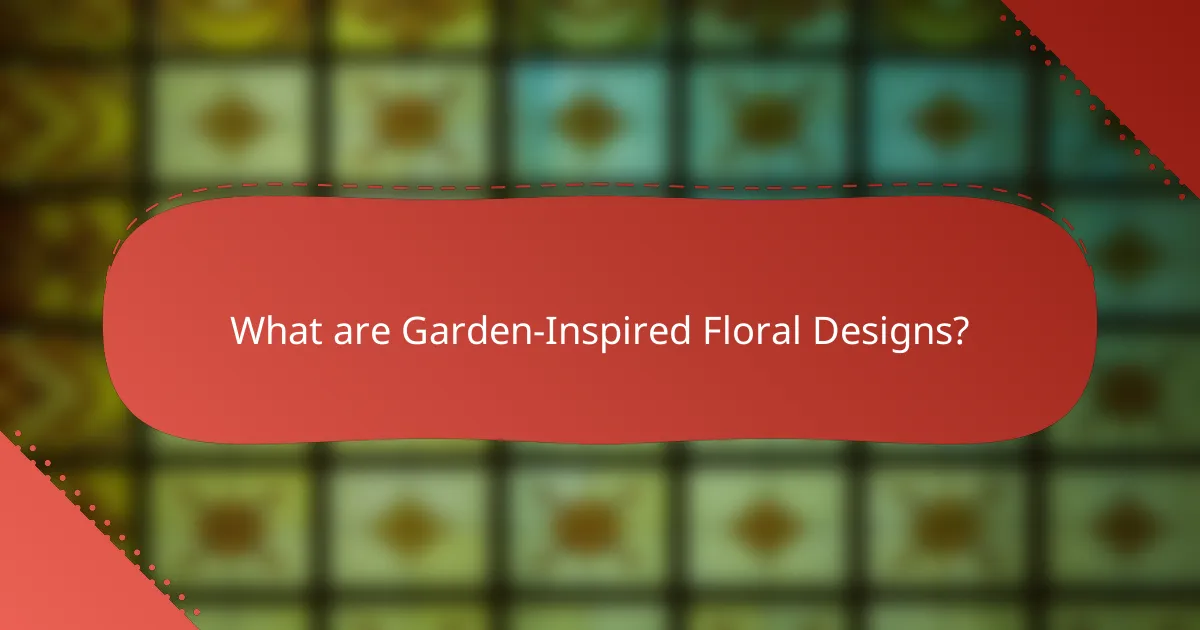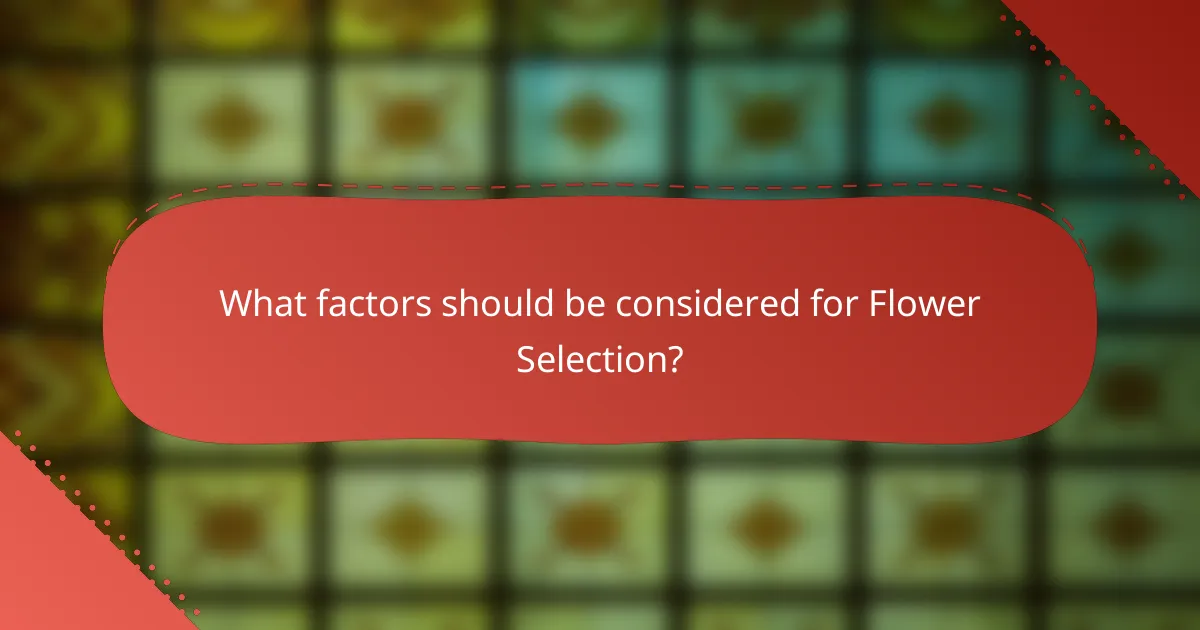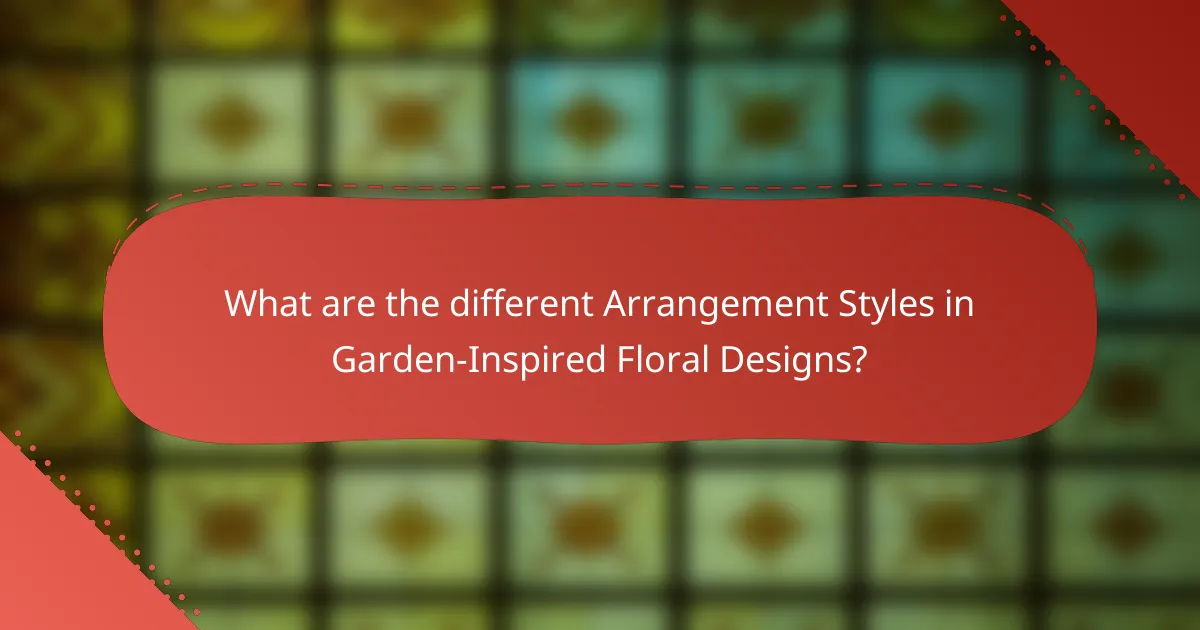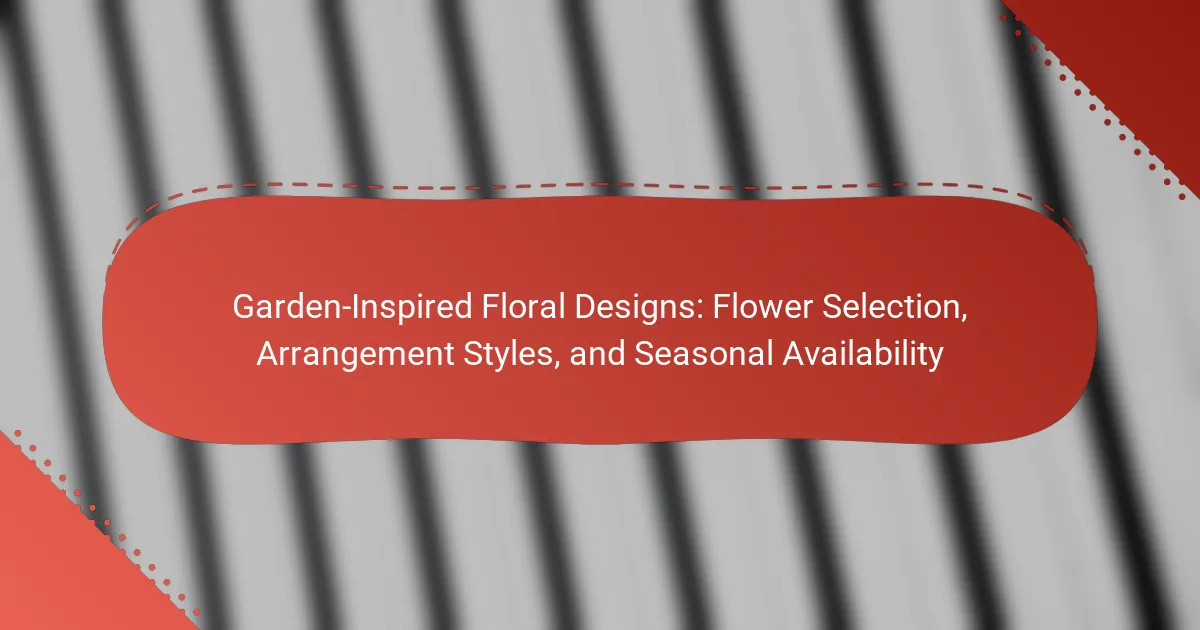
What are Garden-Inspired Floral Designs?
Garden-inspired floral designs are arrangements that mimic the natural beauty of gardens. These designs often feature a mix of seasonal flowers, foliage, and textures. They aim to evoke the feeling of a lush, blooming garden. Common elements include wildflowers, herbs, and greenery. The arrangements may vary in style, from loose and organic to structured and formal. Garden-inspired designs often reflect the colors and forms found in nature. This approach to floral design emphasizes harmony and balance, creating visually appealing compositions.
How do Garden-Inspired Floral Designs differ from traditional floral designs?
Garden-inspired floral designs differ from traditional floral designs in their emphasis on natural, organic aesthetics. Garden-inspired arrangements often utilize a diverse mix of flowers, foliage, and textures, resembling a wildflower garden. Traditional floral designs typically focus on symmetry and uniformity, often using fewer flower varieties.
In garden-inspired designs, the arrangement is more relaxed and asymmetrical. This style captures the spontaneous beauty found in nature. Traditional designs usually adhere to strict patterns and styles, prioritizing formality.
Additionally, garden-inspired designs often incorporate seasonal blooms and locally sourced materials. This approach enhances the freshness and relevance of the arrangement. Traditional designs may rely on imported or out-of-season flowers, limiting their connection to the local environment.
Overall, garden-inspired floral designs celebrate a more casual and varied approach compared to the structured nature of traditional floral designs.
What elements define the aesthetic of Garden-Inspired Floral Designs?
Garden-inspired floral designs are defined by their use of natural elements, color palettes, and organic shapes. These designs often incorporate a variety of flowers, foliage, and textures to mimic a garden setting. The aesthetic emphasizes a loose and free-flowing arrangement style, creating a sense of movement and spontaneity. Color schemes typically include soft pastels and vibrant hues that reflect seasonal blooms. Additionally, the inclusion of greenery enhances depth and dimension, contributing to the overall organic feel. The use of seasonal flowers ensures that the designs remain fresh and relevant, aligning with nature’s cycles. This approach creates an inviting and harmonious visual experience that resonates with the beauty of outdoor gardens.
How do natural landscapes influence Garden-Inspired Floral Designs?
Natural landscapes significantly influence garden-inspired floral designs. They provide inspiration for color palettes, shapes, and textures. Designers often replicate the organic forms found in nature. This includes mimicking the asymmetry of wildflower arrangements. Additionally, the seasonal variations in natural landscapes guide flower selection. For example, spring blooms reflect the vibrancy of blossoming landscapes. Designers also consider local flora to create relevant and harmonious designs. The overall aesthetic is often rooted in the surrounding environment. This connection fosters a sense of place and authenticity in floral arrangements.
What are the key components of creating Garden-Inspired Floral Designs?
The key components of creating Garden-Inspired Floral Designs include flower selection, arrangement styles, and seasonal availability. Flower selection involves choosing blooms that reflect a garden’s natural beauty. Popular choices often include peonies, roses, and daisies. Arrangement styles should mimic organic garden layouts, incorporating varied heights and textures. Seasonal availability ensures that flowers are fresh and vibrant, enhancing the design’s authenticity. Using locally sourced flowers can also promote sustainability. These components work together to create visually appealing and harmonious floral designs that evoke the essence of a garden.
What role does flower selection play in Garden-Inspired Floral Designs?
Flower selection is crucial in garden-inspired floral designs. It determines the overall aesthetic and emotional impact of the arrangement. Different flowers evoke various feelings and convey specific messages. For instance, roses symbolize love, while sunflowers represent happiness. The choice of flowers also influences color schemes and textures in designs. Seasonal availability affects flower selection, ensuring freshness and sustainability. Using locally sourced flowers enhances the design’s connection to nature. Ultimately, thoughtful flower selection enriches the visual appeal and meaning of garden-inspired arrangements.
How do color palettes influence the overall design?
Color palettes significantly influence overall design by affecting mood, perception, and cohesion. A well-chosen color palette can evoke specific emotions. For instance, warm colors like red and yellow create feelings of warmth and energy. Cool colors such as blue and green promote calmness and tranquility.
In floral design, color palettes help to establish a theme and guide flower selection. They ensure that all elements harmonize visually. This harmony enhances the aesthetic appeal of arrangements. Studies show that colors can impact consumer behavior, influencing purchasing decisions.
Incorporating a balanced color palette can lead to more engaging designs. Therefore, understanding color theory is essential for effective floral arrangement.

What factors should be considered for Flower Selection?
Factors to consider for flower selection include climate, color, bloom time, and purpose. Climate affects which flowers thrive in specific regions. Color influences the aesthetic appeal and emotional impact of arrangements. Bloom time determines seasonal availability and longevity of displays. Purpose relates to events, such as weddings or funerals, guiding appropriate choices. Additionally, fragrance can enhance the sensory experience. Pest resistance is crucial for garden longevity. Finally, maintenance requirements influence the ease of care for selected flowers.
How does seasonal availability affect flower selection?
Seasonal availability significantly influences flower selection. Different flowers bloom during specific seasons, affecting the options available for arrangements. For instance, tulips are primarily available in spring, while chrysanthemums are more common in fall. This seasonal cycle impacts both the aesthetic choices and budget considerations for floral designs. Flowers that are out of season may be more expensive or harder to source. Additionally, using seasonal flowers often enhances the theme and natural beauty of arrangements. Studies show that seasonal flowers can last longer and maintain better quality, making them a preferred choice for florists and designers.
What are the best flowers for each season in Garden-Inspired Floral Designs?
The best flowers for each season in garden-inspired floral designs are as follows:
In spring, tulips, daffodils, and hyacinths are ideal. These flowers symbolize renewal and are vibrant in color.
In summer, sunflowers, peonies, and dahlias shine brightly. They add warmth and fullness to arrangements.
In autumn, chrysanthemums, asters, and marigolds are popular choices. Their rich hues reflect the season’s transition.
In winter, amaryllis, poinsettias, and hellebores are favored. They provide color during the colder months.
These selections are based on seasonal availability and their aesthetic appeal in floral designs.
How can one source locally available flowers for designs?
Visit local farmers’ markets to find fresh, locally sourced flowers. Many growers sell directly to consumers at these markets. Establish relationships with local florists who may offer seasonal flowers. Join community-supported agriculture (CSA) programs for regular flower deliveries. Explore local botanical gardens for native species that can be used in designs. Check online platforms that connect consumers with local flower growers. Research local flower farms through agricultural extension offices for additional sourcing options. These methods ensure access to a variety of flowers while supporting local agriculture.
What attributes should be considered when selecting flowers?
When selecting flowers, consider attributes such as color, fragrance, size, and bloom duration. Color impacts the aesthetic appeal and mood of arrangements. Fragrance can enhance the sensory experience of a space. Size determines how flowers fit within a design or arrangement. Bloom duration affects how long the flowers will last in a bouquet. Additionally, consider seasonal availability, as certain flowers may be more accessible at specific times of the year. These attributes ensure that the selected flowers meet both visual and practical needs.
What are the benefits of choosing native flowers for designs?
Choosing native flowers for designs offers numerous benefits. Native flowers are adapted to local climates and soil conditions. This adaptation leads to lower maintenance needs. They require less water and fewer chemical inputs. Native flowers also support local ecosystems. They attract native pollinators, such as bees and butterflies. This promotes biodiversity in the area. Additionally, using native flowers enhances the aesthetic appeal of local landscapes. They provide a sense of place and cultural identity. Studies show that native plant gardens can increase property values. Overall, native flowers contribute positively to both design and the environment.
How do flower sizes and shapes impact arrangement styles?
Flower sizes and shapes significantly impact arrangement styles. Larger flowers serve as focal points in arrangements. They draw attention and create visual weight. Smaller flowers fill gaps and add texture. They enhance the overall composition without overwhelming it. Different shapes influence the flow and balance of the arrangement. Round flowers create a soft, romantic look. Linear flowers add height and structure. These characteristics dictate the overall aesthetic and harmony of the design. For example, a bouquet with large peonies and small daisies achieves a balanced contrast. Understanding these dynamics helps florists create visually appealing arrangements.

What are the different Arrangement Styles in Garden-Inspired Floral Designs?
The different arrangement styles in garden-inspired floral designs include naturalistic, loose and airy, structured, and compact arrangements. Naturalistic arrangements mimic the organic growth patterns found in gardens. Loose and airy styles feature flowers arranged in a relaxed manner, often with negative space. Structured arrangements emphasize geometric shapes and formality. Compact arrangements group flowers closely for a dense and lush appearance. Each style reflects the essence of garden aesthetics, allowing for creativity and personal expression in floral design.
How do different styles enhance the beauty of floral arrangements?
Different styles enhance the beauty of floral arrangements by creating distinct visual impacts. Each style, such as traditional, modern, or wildflower, brings unique characteristics to the arrangement. Traditional styles often emphasize symmetry and balance, which appeal to classic aesthetics. Modern styles may incorporate minimalism and bold shapes, attracting contemporary tastes. Wildflower arrangements celebrate natural, organic forms, evoking a sense of spontaneity and charm.
These stylistic choices can influence the perception of color and texture in the arrangement. For example, a modern style may highlight vibrant colors against a neutral background, enhancing visual contrast. In contrast, traditional styles might use softer hues for a more cohesive look.
Moreover, different styles can cater to specific occasions or themes. For instance, elegant arrangements are suited for formal events, while casual styles fit relaxed gatherings. This adaptability allows for personalized expressions of beauty in floral design. Ultimately, the diversity of styles ensures that floral arrangements can resonate with individual preferences and settings.
What are common arrangement styles used in Garden-Inspired designs?
Common arrangement styles used in Garden-Inspired designs include naturalistic, loose, and formal arrangements. Naturalistic arrangements mimic the look of wildflowers in nature. They often feature asymmetrical designs and varied heights. Loose arrangements emphasize a relaxed, casual feel. They incorporate mixed flowers and foliage for a vibrant look. Formal arrangements are structured and symmetrical. They often use fewer flower types and emphasize geometric shapes. Each style reflects the essence of a garden setting, creating a harmonious visual experience.
How can one incorporate different textures in arrangements?
Incorporating different textures in arrangements involves using a variety of floral and foliage elements. Textures can be achieved by combining smooth petals, spiky leaves, and feathery blooms. For example, pairing velvety roses with textured thistles creates visual interest. Additionally, mixing glossy leaves with matte-finished flowers enhances depth. Layering elements with varying shapes, such as round blooms and elongated stems, adds dimension. Using natural materials like twigs or stones introduces organic texture. Seasonal flowers often provide diverse textures, allowing for creative combinations. These techniques result in visually appealing and dynamic floral arrangements.
What techniques can improve the effectiveness of floral arrangements?
Using color theory can improve the effectiveness of floral arrangements. Complementary colors create visual interest. Analogous colors provide harmony and unity. Balance in arrangement ensures stability and appeal. Varying heights adds dimension and draws the eye. Using texture enhances sensory engagement. Incorporating negative space prevents clutter and focuses attention. Seasonal flowers ensure freshness and relevance to the occasion. These techniques enhance the overall aesthetic and emotional impact of floral designs.
How does layering and grouping affect the visual appeal?
Layering and grouping enhance visual appeal by creating depth and organization in floral arrangements. Layering involves placing flowers at varying heights, which adds dimension. This technique draws the viewer’s eye and creates interest. Grouping refers to clustering similar flowers together, which provides harmony and balance. These methods help to emphasize colors and textures. Research shows that well-organized arrangements are more visually pleasing. According to the principles of design, balance and contrast are key to aesthetic appeal. Thus, effective layering and grouping significantly elevate the overall beauty of floral designs.
What are tips for achieving balance and harmony in arrangements?
Achieving balance and harmony in arrangements involves careful consideration of proportions, colors, and textures. Use a variety of flower sizes to create visual interest while maintaining a cohesive look. Balance can be achieved by distributing larger blooms evenly throughout the arrangement. Incorporate complementary colors to enhance harmony and create a pleasing aesthetic. Textures should also vary, mixing smooth and rough elements for depth. The rule of thirds can guide placement, dividing the arrangement into sections for better visual balance. Additionally, ensuring that the arrangement has a focal point draws the eye and unifies the design. Consistent spacing among flowers contributes to overall harmony, preventing overcrowding.

How can one effectively plan for Seasonal Availability?
To effectively plan for seasonal availability, one should research the blooming cycles of flowers. Understanding the specific months when flowers are in season is crucial. For example, peonies bloom in late spring, while sunflowers are available in summer. Creating a calendar that outlines these blooming periods can aid in planning. Additionally, sourcing local suppliers ensures fresh flowers that are in season. This practice reduces costs and enhances sustainability. According to the American Society of Floral Designers, seasonal flowers are often more vibrant and fragrant. Planning ahead allows for better arrangement styles that reflect the season’s characteristics.
What are the best practices for planning floral designs around seasons?
The best practices for planning floral designs around seasons include selecting flowers that are in season. Seasonal flowers are fresher and more vibrant, enhancing overall design quality. For spring, choose tulips and daffodils. Summer designs can feature sunflowers and peonies. In autumn, opt for chrysanthemums and dahlias. Winter arrangements can include evergreens and poinsettias.
Additionally, consider color palettes that reflect seasonal themes. For example, pastel colors suit spring, while rich oranges and reds are ideal for fall. Texture variation adds depth to arrangements and can be achieved using seasonal foliage.
Lastly, understanding local climate conditions is crucial. This ensures the selected flowers thrive in their intended environment. Following these practices leads to cohesive and visually appealing floral designs throughout the year.
How can seasonal changes influence design choices throughout the year?
Seasonal changes significantly influence design choices throughout the year by dictating the availability of flowers and colors. Different seasons offer distinct blooms, with spring showcasing tulips and daffodils, summer featuring sunflowers and roses, autumn highlighting chrysanthemums, and winter presenting poinsettias and evergreens. Designers adapt their arrangements to reflect seasonal aesthetics and themes. For example, bright, vibrant colors in summer contrast with the muted tones of fall. Seasonal trends also affect material choices, with lighter fabrics in warmer months and heavier textiles in colder seasons. This adaptability ensures that floral designs resonate with the natural environment and cultural celebrations. Ultimately, aligning design choices with seasonal changes enhances visual appeal and relevance.
What resources are available for tracking seasonal flower availability?
Resources available for tracking seasonal flower availability include online databases and mobile applications. Websites like the American Society of Florists provide seasonal guides. The Bloom & Wild app offers real-time information on flower seasons. Local farmers’ markets often have seasonal flower lists. Additionally, gardening books and magazines frequently publish seasonal availability charts. These resources help consumers and florists plan their floral arrangements effectively.
What practical tips can enhance Garden-Inspired Floral Designs?
Use a variety of flowers to create depth in garden-inspired floral designs. Incorporate seasonal blooms for freshness and vibrancy. Choose complementary colors to enhance visual appeal. Utilize different heights in arrangements for dynamic shapes. Add greenery to provide contrast and texture. Experiment with natural containers to evoke a garden feel. Incorporate elements like branches or berries for added interest. Pay attention to fragrance to create a multi-sensory experience.
How can one maintain freshness and longevity of flowers in arrangements?
To maintain freshness and longevity of flowers in arrangements, ensure proper hydration. Place flowers in clean water immediately after cutting. Use flower food to provide nutrients and inhibit bacterial growth. Trim stems at an angle to enhance water absorption. Remove leaves below the waterline to prevent decay. Change the water every two to three days to keep it fresh. Keep arrangements in a cool location away from direct sunlight and heat sources. These practices can extend the lifespan of flowers significantly, often by several days to a week.
What are common mistakes to avoid in Garden-Inspired floral design?
Common mistakes to avoid in Garden-Inspired floral design include poor flower selection. Using flowers that do not complement each other can disrupt harmony. Neglecting seasonal availability leads to wilted or out-of-season blooms. Overcrowding arrangements makes them look cluttered and unbalanced. Ignoring the scale of the arrangement can result in disproportionate visuals. Failing to consider the setting conflicts with the overall aesthetic. Not incorporating foliage can make designs appear sparse. Lastly, overlooking maintenance needs can lead to quick deterioration of the arrangement. Each of these mistakes detracts from the intended beauty and effectiveness of the design.
Garden-inspired floral designs are arrangements that emulate the natural beauty of gardens, incorporating a mix of seasonal flowers, foliage, and textures. This article explores the distinctions between garden-inspired and traditional floral designs, emphasizing their organic aesthetics and varied arrangement styles. Key components such as flower selection, seasonal availability, and the influence of natural landscapes are discussed, along with practical tips for creating harmonious and visually appealing designs. Additionally, the article highlights the importance of color palettes, texture incorporation, and best practices for maintaining flower freshness in garden-inspired arrangements.
